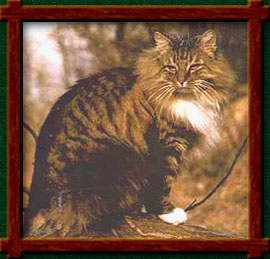|
|

|
|||
|
By its name and its looks the Norwegian Forest Cat may give the impression that it is a kind of European wild cat: both are larger than the ordinary house cat, have a thick plucking tail and have black lines on a background of feral colour (the most common colour in this breed). But in character these two species cannot diverge more. While it is absolutely impossible to domesticate a wild forest cat, the Norwegian Forest Cat is a real homebody: it is friendly, adapts easily and loves company.
The most important character features of the Norwegian Forest cat in a row: good-natured, pleasant, quiet, alert, intelligent, tolerant, curious, brave, merry and social. The ‘Wegie’, as it is affectionally called in English speaking countries, is playful - frequently up to a very old age – is active and needs regular physical exercise. It's still recognizable that its ancestry lies in the forests: the cat is |
Pan's Truls - the role model for the Norwegian Forest Cat, with a wild look and in the 'traditional' colours... |
|||
|
an exceptionally good climber, a tremendous hunter and has an ancient instinct to be extra alert and watchful in surroundings or situations it is unfamiliar with.
Yet this cat will feel very well at home living in an apartment, provided that it has sufficient ‘room to swing’, a large, firm climbing device and the possibility to get some outdoor air from time to time (secured!). Especially in winter, when the house is heated, the cat needs fresh air, which also provides a better quality of its coat.
Norwegian Forest Cats are fond of company, attention and cuddling. They enjoy being with people and other pets and are excellent with children. They are very patient animals and are not stressed easily. They are fairly intelligent and have a natural curiosity. Often a Wegie has a fancy for one specific family member and will look for that special person’s attention and cuddles. Although generally not a lap cat, the Wegie will spend a lot of hours nearby ‘its’ human.
Due to its curiosity and intelligence the Forest Cat will learn easily during play: it can be ‘trained’ to run and fetch, to walk on a bridle or to come if it is called. When this cat has sufficient playtools and -mates and is able to spend its energy, it will make a happy, entertaining, exciting and loving friend.
All in all the Norwegian Forest Cat is the ideal cat for people who like a beautiful, affectionate breed cat, but don’t hold with the so-called culture breeds – in which breeding has sometimes resulted in extreme external characteristics and even to physical deficiencies (such as permanent teary eyes and breathing-difficulty). The Wegie still is ‘pure nature’ and most hobby-breeders will exert themselves to keep it this way.
The Norwegian Forest Cat combines a tough, wild appearance with a friendly, affectionate character. It’s very well possible that just this unusual combination is the reason why so many cat lovers find this breed so addictively nice and attractive.
Singularities: Some more specific breed aspects of the Norwegian Forest Cat are interesting and important to mention yet:
for the origin of the Norwegian Forest Cat and the recognition of the breed click HERE
for the breed standard of the Norwegian Forest Cat click HERE
|
||||
|
|
|
|||




